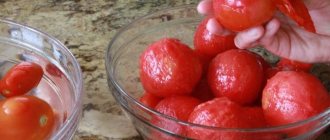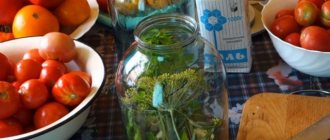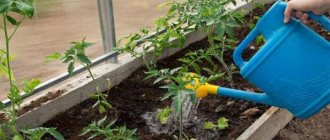Varieties for long-term storage
To ensure that the harvest is stored for a long time, those varieties that are characterized by high shelf life are selected for planting. Tomatoes are not washed; heavily soiled ones are wiped with a soft cloth, trying not to spoil the skin.
Experienced vegetable growers harvest slightly unripe tomatoes of the following varieties:
- De Barao is a mid-season tomato, the height of the bush reaches 3 m. The fruits are oblong, of different colors - from yellow to brown.
- San Marzano is a variety with dense, juicy fruits of bright red color, plum-shaped, weighing up to 140 g.
- Rio Grande is a mid-season variety with high yield.
There are special varieties and hybrids bred for long-term storage:
- Giraffe is a variety that reaches a height of 1.2 m. It is a late-ripening variety and is cultivated in open ground and under film covers. The fruits are stored until the end of spring.
- Long Keeper is a late-ripening variety, tomatoes reach 450 g. They are stored fresh until spring.
- Masterpiece-1 is a late-ripening, low-growing hybrid; its bush grows up to 65 cm. Red, flat fruits weighing about 200 g are stored until March.
How to properly harvest tomatoes for storage
The harvest is harvested before night frosts, since frozen fruits will not be stored for long. Basic collection rules:
- tomatoes are harvested during the day, when there is no morning dew on them;
- to extend shelf life, the collected fruits are sorted;
- choose only ripe vegetables and fruits ripened to milky ripeness;
- All collected tomatoes are wiped with alcohol for disinfection.
Processing methods
Whatever method is chosen, vegetables must undergo simple preparation. This will increase shelf life and maintain a fresh aroma.
- First of all, it is necessary to sort the fruits by size and degree of ripeness. Since ripe and unripe tomatoes are stored at different temperatures, and large specimens ripen much earlier than small ones.
- For storage, choose undamaged and strong tomatoes, since the slightest rot can damage the entire crop.
- To ensure that tomatoes last a long time, they are removed from the bush before the first frost, along with the stalks.
- Before planting, the fruits are dried and treated with a 0.3% solution of boric acid or a weak solution of potassium permanganate.
After sorting and processing, you can proceed to the second stage - bookmarking.
Cherries are not suitable for long-term storage due to their thin peel.
How to store the harvest
Fleshy, sugary tomatoes are the worst to store, as they quickly begin to ferment and become unsuitable for consumption. Slightly unripe tomatoes stay fresh for 2-3 days longer than ripe ones because their flesh is still hard. Overripe fruits are eaten immediately, as they do not last long.
On a note . Regardless of the variety, tomatoes grown outdoors are better preserved than those grown in greenhouses.
How to store tomatoes in a cellar or basement
The suitable temperature for maintaining the freshness of tomatoes is +10-15°C, so the best place to store picked tomatoes is a basement or cellar. In the cellar, tomatoes are placed in wooden boxes in layers, separating the layers with paper. If possible, each tomato is wrapped in paper wrapper. Do not put more than three layers in boxes, otherwise the bottom row will deteriorate from the weight of the top ones.
If there is no cellar, then vegetables are stored on the floor - for example, in a pantry. Unripe tomatoes are left at room temperature, where they ripen over time.
Features of storage on the balcony
A suitable place to store ripe tomatoes is a balcony if the air temperature does not exceed +15°C. Tomatoes are stored there in the same way as in a cellar or basement: they are laid in layers, each layer covered with cloth or paper. The boxes themselves are also covered with fabric to protect them from sunlight.
How to store fresh tomatoes in jars
Canning is a method of long-term storage. In jars, tomatoes remain usable for 4-6 months.
Ripe tomatoes are washed and dried, then placed in a three-liter sterilized jar. Pour 3-4 tbsp. l. alcohol, cover with a nylon lid and shake so that all the tomatoes are well wet. Then a thread soaked in alcohol is placed in the middle and set on fire from the outside. When the alcohol starts to burn, immediately cover the jar with a metal lid.
On a note. For long-term storage, jars are placed in a cool, dark place.
In boxes
Tomatoes are kept in wooden boxes with slits to allow oxygen to reach them. The boxes are covered with gauze or cotton cloth, but not with a lid. There should be no foreign odors in the container. To protect the tomatoes from moisture, dry hay is placed at the bottom.
In the sawdust
To keep tomatoes in boxes longer, use sawdust. If the crop is still slightly unripe, it is placed in boxes, if possible in wooden ones, with the top to the top (where the stalk was - this is the top). Under each layer, paper is placed and sawdust is poured, which will absorb moisture and protect the fruits from rot.
To make this storage method more effective, the boxes are placed in a dry and dark place at an air temperature of no more than +10-15°C. It is better to store tomatoes in the cellar, basement or on the balcony if the side is not sunny. The box is covered with gauze or paper.
Indoor storage
Ripe tomatoes are poorly stored at temperatures higher than +22°C. Because tomatoes contain a lot of sugar and juice, warm conditions create a favorable environment for fermentation. Fleshy fruits with a thin peel are stored at room temperature for no more than 2-3 days. If the tomato has a thick shell and dense pulp, then the vegetables will be stored for up to 6-7 days.
Important! To avoid poisoning from stale products, tomatoes should not be stored at room conditions for longer than this period.
In paper
If the fruits are in newspaper or paper, they will be stored for a long time not only in the refrigerator, but also in a box or basket. The main thing is not to put a large number of tomatoes on top of each other; 1-2 layers will be enough.
Storing in a pan
For long-term storage, tomatoes are pickled in a saucepan. To do this, cut half of the tomatoes into equal parts. Place a layer of chopped vegetables in a pan, sprinkle with salt, then a layer of whole ones. And so on several times until the container is completely filled.
On a note. Regardless of the method you choose, inspect your inventory periodically. If a tomato begins to spoil, remove it immediately so that it does not infect others.
In jars with mustard
The tomatoes are thoroughly washed with hot water and dried. Pour 2 tbsp into a sterilized jar. l. mustard powder. Tomatoes are placed in it and each layer is sprinkled with mustard. A three-liter jar should take no more than 7 tbsp. l. powder. The jar is sealed and stored in a cool place.
Interesting points when storing tomatoes
- Tomatoes wiped with a cotton swab dipped in alcohol will stay fresh a little longer. We carry out the procedure before the bookmark itself.
- Fruits picked from a branch are stored better.
- Do not store tomatoes in a plastic bag in the refrigerator. Where, as a result of condensation, the process of rotting can begin. And this will be facilitated by low temperature.
- Tomato ripening at home occurs quickly. And in order to prolong this process, the fruits need to be separated from each other with sawdust or by wrapping the fruits in paper.
- In the refrigerator, vegetables are stored wrapped in paper.
- No need to wash before storing. The fruits must be dry.
- If storage occurs in boxes, then the bottom should be lined with paper and the fruits should be sprinkled with sawdust. We periodically check the tomatoes and remove spoiled fruits.
- In stores, tomatoes are kept in refrigerators, so they will be stored worse at home than your own tomatoes. Note that low temperatures affect the taste and properties of tomatoes.
Cold storage
Where is the best place to store ripe tomatoes? Using regular newspaper, tomatoes can be stored in the refrigerator for up to two weeks. Each vegetable is wrapped in a paper bundle or combined in three pieces into an envelope. The goal is to keep the tomatoes from getting soggy. The optimal place to store tomatoes in the refrigerator is the bottom shelf for vegetables. The newspaper is changed periodically, and the shelf in the refrigerator is wiped dry.
On a note . Do not store tomatoes in a closed plastic bag, as they can quickly spoil due to condensation.
But when stored in the refrigerator, tomatoes lose their fresh taste. The volatile substances they contain, which give the aroma and familiar taste, do not withstand low temperatures and are destroyed.
How to preserve fresh tomatoes in a jar
You can store more than just money in a bank. You and I will put fresh tomatoes there. They will still be fresh when you take them out.
Method 1
You will need clean sterilized jars, tomatoes and any vegetable oil. Place pre-washed and completely dried tomatoes in a jar and fill to the top with oil. The oil should cover the tomatoes completely, even with a small margin. Roll up with a metal lid (also sterile) and forget about them until the New Year.
Method 2
The jars must again be sterilized, the tomatoes washed, dried and placed in them. However, instead of oil this time, pour a vinegar-salt solution over the fruit. To prepare it, add 1 part vinegar and salt to 8 parts water. Roll up the jars.
Storing Processed Tomatoes
Tomatoes are not only stored fresh. Heat-treated, long-storable fruits are used for food. In terms of taste, they are not inferior to fresh vegetables.
Canned, dried and dried fruits last much longer and do not require special storage conditions:
- Hermetically sealed canned tomatoes can be stored for a long time even at room temperature. Such blanks last up to a year.
- If vegetables are fermented or pickled and kept under a nylon lid, they can be stored for up to six months.
- Dried tomatoes are stored in the same way as sun-dried ones. They are placed in bags made of natural fabrics or in paper bags to provide oxygen access to the vegetables and prevent the penetration of dust and insects. Dried tomatoes are stored in a dry and dark place.
How to store homemade tomato preparations
The main recommendation for homemade preparations is storage in a dark and cool place. A cellar, closed balcony or refrigerator is suitable for these purposes.
Drying tomatoes for the winter - a delicacy from the Mediterranean
Juicy and aromatic sun-dried tomatoes will be a pleasant addition to the table during the winter cold. They are first dried in an electric dryer and then stored in olive oil with spices.
Ingredients:
- tomatoes – 4 kg;
- sea salt – 1.5 tsp;
- “Italian herbs” spices – 2 tsp;
- garlic – 1.5 heads;
- olive oil – 250 ml.
Preparation:
- cut the tomatoes in half, remove the stem;
- select the seeds using a knife;
- Place the tomatoes in a heated electric dryer in rows;
- salt and sprinkle Italian herbs on each layer on the trays;
- leave to dry at +70°C for 10-12 hours;
- change the trays every 2-3 hours for better drying;
- When the tomatoes are completely dry, remove them from the electric dryer;
- cut the garlic into small pieces;
- Place sun-dried tomatoes, chopped garlic in pre-sterilized glass jars and add olive oil.
Cover the resulting delicacy with a lid and put it in a dark, cool place.
Important! For drying, it is better to choose dense, not very watery varieties. Preference is given to fruits 4-5 cm long.
Storage conditions and location
To preserve tomatoes for a long time, you must adhere to temperature and humidity conditions. +8–10 degrees are considered optimal, with an air humidity of 80%.
Tomatoes are very sensitive to sudden changes in temperature, and if the thermal balance is disturbed, they become lethargic and lose their unforgettable aroma.
The location chosen for storage also plays an important role. Any dark room is suitable for this: a basement, a pantry, a closed vegetable compartment in the refrigerator, or the space under the bed.
General recommendations
It is not recommended to buy fruits for storage in supermarkets. It is better to take those grown in the garden or buy them at the market.
Advice from experienced housewives:
- To keep the fruits longer, they are removed along with the stalk.
- Vegetables damaged by rot or parasites should not be stored in the same container as whole vegetables.
- Tomatoes are stored in a cool, dark place - in the basement, pantry, under a table, sofa or bed.
- Tomatoes are periodically checked for rot. The spoiled ones are thrown away so that the rest do not start to rot.
- Vegetables are stored strictly with the stalk facing up, since the skin around it is tender, and under the weight of the tomatoes it can crack, and then the tomato will begin to deteriorate.
- For long-term storage, each fruit is wrapped in paper and placed in boxes or baskets in no more than 1-2 rows.
- Do not store vegetables in a plastic bag, since it will not be possible to keep tomatoes fresh for a long time due to high humidity.
Green tomatoes: where to put them to ripen?
Green tomatoes or vegetables that are at the stage of milk ripeness are well suited for winter storage. It is advisable to collect green tomatoes in late autumn. Each specimen can be wrapped in thin paper and then placed in layers in a wooden or plastic box, first covering the previous layer with straw or hay. Then the boxes are removed to a cool room where the temperature is maintained no higher than +10+12 degrees. Tomatoes can stand from October-November until January, gradually ripening.
Housewives are also interested in how to store tomatoes at home if they have not ripened in the garden and they need to speed up the process of ripening vegetables. To solve this problem, you need to place the green fruits for 5-10 days in a warm room, where the air temperature is +25 degrees or higher. Vegetables can be laid out directly on the floor in boxes or hung from the ceiling.
And, of course, the method of storing green tomatoes on the windowsill is always popular. After all, sunlight penetrates well here, and the ripening process goes much faster.
Also, do not forget that already ripened fruits significantly accelerate the ripening of green specimens. It is enough to add 1-2 red tomatoes to green tomatoes.











